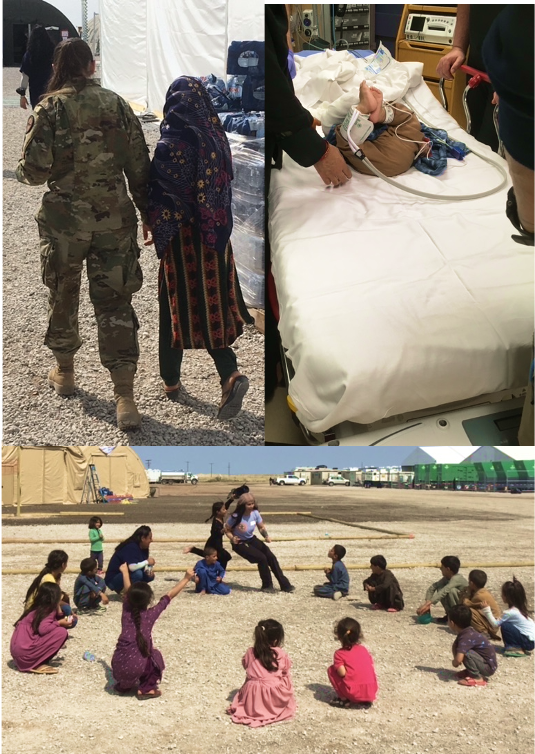By Nellie Bly
Prologue: This was written over the course of several deployment periods of one to three weeks. Aman Omid Village on Holloman Air Force Base closed at the end of January 2022, having in-processed and placed 16,000 Afghani evacuees. All but eight survived. For the five months it existed, and adjusting for average population, the Village death rate was about one-third that of the general U.S. population.
Each family got a tiny cubicle about the size of a walk-in closet, comprised of stud-height walls of black plastic sheeting with open ceilings to the high tent roofs. Each tent held hundreds of such cubicles and hundreds of families.
There were nine such tents, and the Air Force was building several more. It took them about three days. None of this huge compound had existed a month ago. We were expecting another 2,500 refugees soon.
The physical facility was ginormous and awesome. I talked to a tanker driver and learned that running the village took 100,000 gallons of diesel per month.
The village dining halls were segregated by adult gender. There were three mosque tents, identifiable by their orientation, a little askew of the orderly pattern of the other tents. Religious east is not the same as compass east. The mosque tents were aligned to point in the most direct line toward Mecca.
Everyone was dehydrated. Even our million or so bottles of filtered water tasted weird to the Afghan palate, and urination more than twice a day was considered unusual. Villagers squatted on top of the seat of the portable toilets. Even though that’s a physiologically better position for defecation, we used the ones for the EMED (Expeditionary MEDicine) staff; squatting and aiming were incompatible. The portable toilets accessible to the villagers were filthy. And they preferred to drink the water from the hand-washing stations.
COVID was the least of our worries. Tuberculosis, measles, hantavirus, plague, and bacterial meningitis were endemic. We had eight isolation tents, all full, with about 220 patients. Most of them successfully ruled out, while the rest remained for treatment until non-contagious.
I was the first person to get the COVID Pfizer booster in Alamogordo. The cutting-edge public health operation in the city is WalMart.
I was impressed with our Air Force members. Having erected these structures, they recognized the need for privacy and safe haven. We were the only ones allowed to enter the residence tents, unless we requested airmen for security or patient handling assistance
Most of the medically unstable population had already arrived as priority evacuees. They were profoundly weak, dehydrated, often with respiratory disease, all aggravated by long flights. The early evacuees were not housed or cared for in our overseas bases prior to arriving at Holloman AFB, and were flown directly from Kabul. Some were in very rough shape physically and medically. Later flights were of Afghanis temporarily housed and processed in our overseas bases before transport here.
We waited on the taxiway for incoming flights, to assist those unable to move unaided, or who had deteriorated in flight. The first evacuees arrived at Holloman in late August. A steady stream continued to arrive by plane, replacing some who were processed out into host families, communities, and cities.
Two generations ago, the U.S. airlift from Vietnam was similarly handled, with a number of metropolitan areas, including Seattle and Albuquerque (two of my hometowns) serving as centers for assimilation. There is a nationwide movement in the Vietnamese-American community to step up now as hosts and sponsors for these Afghani families.
The Air Force built two soccer fields and rough volleyball courts. One day, we had a brief period of downtime and managed to spend a few hours playing with kids, dispensing with talk in favor of the universal language of play. Simple magic tricks, mutually shared, and an improvised game of Duck, Duck, Goose. The children were feral, completely unsupervised, captivating, and initially very reserved.
Our awesome woman paramedics were, like the mythic Amazons, fearless and engaging, and made short work of the kids’ shyness. One was a bodybuilder and single mom. Another held a world record in the Highlander Games. You know, the ones where they throw telephone poles and rocks and cars. Well, maybe not cars.
On one tour, I worked with four women from the Alamo Band of the Navajo Reservation. They normally worked in a remote community 75 miles from the nearest basic hospital. All of them had been responders to a national news-level accidental mass carbon monoxide poisoning during a traditional ceremony in a Hogan involving 16 patients, 5 in cardiac arrest, and several children. The rescuers personally knew and were related to all the patients. Each of them, when one on one, told me of their experiences on that call, still needing to talk about it two years later.
Each of our ambulance teams has a male and female EMS provider, with at least one and often two paramedics, and an EMT-intermediate. Responses range from scene calls in the tents and triage clinic, occasionally injured airmen, and patients originating from the on-site EMED field hospital, to EMED or Champion Regional Medical Center in Alamogordo, the only joint civilian-military chartered hospital in the U.S.
“Desert” was a misleading term for our location, even though the norm was dust and austerity, as the decades-old sage and chamisa which bind the scant topsoil were scraped away to make level construction and staging areas. An epic monsoon we dubbed “Mudpocalypse” once ripped through and dumped a massive amount of hail and rain, flooding some of the facilities, and washing away our scavenged plywood “deck.” We sunk one ambulance to the hubs in sudden quicksand, where it remained trapped for 14 hours.
The public address system sounded Muslim prayer, with vocalizations that chilled, especially at sunset. Followed by the Star-Spangled Banner.

